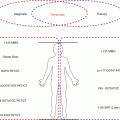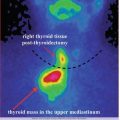(1)
Institute of Oncology “Prof. Ion Chiricuță”, Nuclear Medicine & Endocrine Tumors, Cluj-Napoca, Romania
The beginning of wisdom is to call things by their right names.
– Chinese proverb –
Radioactivity—The rate at which nuclear transformations occur; the International System of Units (SI) unit is becquerel (Bq) = 1 transformation/s.
Becquerel (Bq)—Unit of radioactivity, corresponding to one radioactive disintegration per second.
1 Bq = 1 disintegration/s
1 MBq (megabecquerel) = 106 Bq
1 GBq (gigabecquerel) = 109 Bq
Curie (Ci)—Former unit of radioactivity, corresponding to 3.7 × 1010 radioactive disintegrations per second. Now replaced by the becquerel.
1 Ci = 3.7 × 1010 disintegrations/s
1 Ci = 3.7 × 1010 Bq = 37 × 109 Bq = 37 GBq
Absorbed dose—The amount of energy imparted by ionizing radiation to mass unit. The absorbed dose is measured in a unit called gray (Gy). A dose of 1 Gy is equivalent to a unit of energy J (joule) deposited in 1 kg of substance.
1 Gy = 1 J/kg
Gray (Gy)—The name for the unit of absorbed dose, in the SI. The previous, old, unit of absorbed dose, rad, has been replaced by the gray.
1 Gy = 100 rad
Rad—The former unit of absorbed dose, equivalent to an absorption energy of 10−2 J/kg; one rad is equal approximately to the absorbed dose delivered when soft tissue is exposed to one roentgen of medium-voltage radiation.
1 rad = 0.01 Gy
Equivalent dose—The absorbed doses in the tissue or organ due to radiation. The radiation weighting factor W R measures the relative harmfulness of different radiations; the SI unit is sievert (Sv).
Effective dose—The sum of the weighted equivalent doses in all tissues or organs of the body. It is also called the biological dose, used in radioprotection, as it determines how dangerous an individual’s exposure to radiations can be; the SI unit is sievert (Sv).
Sievert (Sv)—Unit of the equivalent dose or effective dose in the SI system. Sv replaces the classical radiation unit: the rem. Submultiples of sievert (symbol Sv) used in practice include millisievert (mSv) and microsievert ( μSv).
1 Sv = 100 rem
1 mSv = 100 mrem = 0.1 rem
Rem—Former unit of equivalent and effective dose. It is the product of absorbed dose (in rads) and the radiation weighting factor.
1 rem = 1 × 10−2 Sv = 0.01 Sv = 10 mSv
1 mrem = 0.01 mSv
1 mrem = 0.01 × 103 μSv = 10 μSv
Collective effective dose equivalent—The sum of individual effective doses in a population used to assess collective risks, unit person-Sv (man-Sv).
Roentgen (R)—A unit of exposure to ionizing radiation. It is the amount of γ- or X-rays required to produce ions carrying one electrostatic unit of the electric charge (either positive or negative) in 1 cm3 of dry air under standard conditions of pressure and temperature.
A coulomb (C) per kilogram (C/kg) is the derived SI unit of ionizing radiation exposure. It is a measure of the amount of radiation required to create 1 C of charge of each polarity in 1 kg of matter.
1 C/kg = 3876 R
1 R = 2.58 × 10−4 C/kg
X-ray—A penetrating form of electromagnetic radiation admitted either if the inner orbital electrons of an excited atom return to their normal state (these are characteristic X-rays) or if a metal target is bombarded with high-speed electrons. X-rays are always nonnuclear in origin.
Stay updated, free articles. Join our Telegram channel

Full access? Get Clinical Tree








